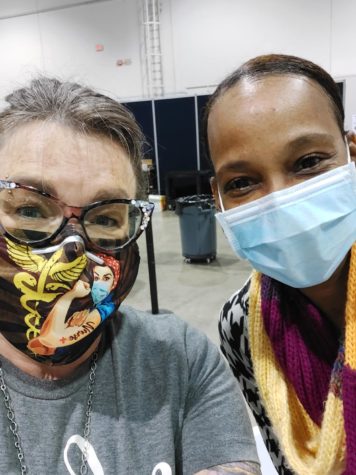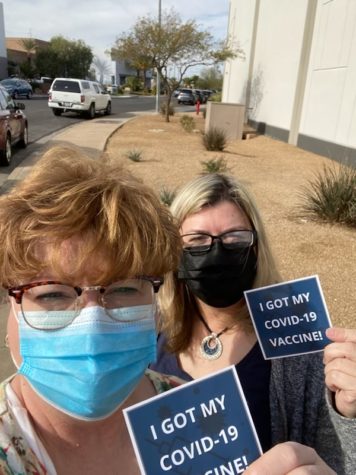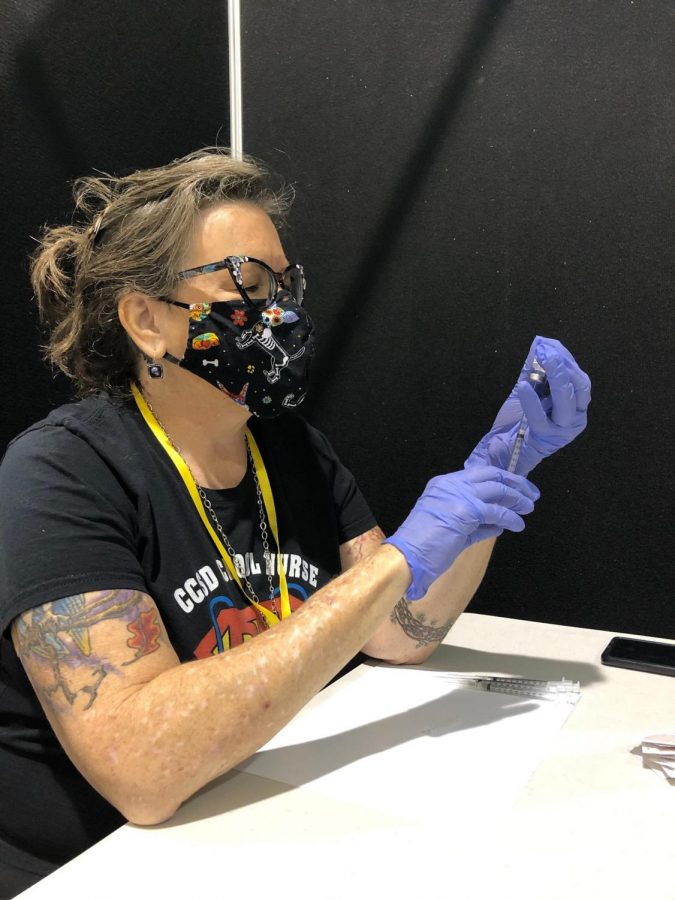Ryan prepares to administer COVID-19 vaccines on Feb. 6 at Cashman Center.
CCSD school nurses, medical personnel help with local vaccinations
School nurse Meg Ryan prepares and administers vaccines
March 13, 2021
Students may think of our campus health office as the place where they give us band-aids, take our temperature when we’re feverish and call our parents to come get us when we’re sick. But school nurses also administer medicine, test our hearing and vision, aid in emergencies and manage care for many students with specialized health needs. They often educate, collaborating with other education staff to help students with special medical needs such as diabetes, and training others to triage for injuries or to perform CPR. In the middle of a pandemic, our CCSD school nurses have added another role as key members of the community effort to vaccinate the population in Clark County, joining in with other medical staff to help us gain herd immunity.
Chapter 1: Front lines of giving the vaccine
The COVID-19 vaccine has been long anticipated by many. In earlier stages of the pandemic, there was a belief that everything would be better once the vaccine was created. Now that the vaccine is here, though, will this vaccine still be the “miracle cure” that could set everything back to normal?
Megan Ryan is a registered nurse with a masters degree who has been a nurse for 34 years, working at schools for 24 years, and employed at Silverado for six. She is one of the 200 school nurses who has been a part of the COVID-19 vaccine administration team here in Las Vegas.
“The vaccine will help, but we’re only in tier one (that includes teachers and school staff fortunately),” Ryan said. “But until most of the general population can get vaccinated, we’ve got a ways back to ‘normal.’”
However, we are still on the path towards “normalcy.” Advancements such as the vaccine are steps toward a healthier future. People also must come together to protect themselves and others in any way they can.
“I think if we keep doing what we are doing–social distancing and wearing masks–it does make a difference,” Ryan said.
Chapter 2: Understanding the vaccine
Working together, and working with an understanding of science, we can take steps to further control and prevent the spread of COVID-19.
But is the vaccine even safe? How rushed was the process?
The process behind the vaccine itself is very complicated and often hard to understand. Now that there is a vaccine here, many people are questioning if it is safe to take it, and what unforeseen repercussions a “rushed” vaccine will have. Others have decided to wait before taking the vaccine, as to stay out of a “testing period.”
“I know that people think that this vaccine was developed ‘too quickly,’ so they question the safety,” Ryan said. “[But] this type of vaccine is one that has been used for years. Every year, they modify it by adding an ingredient (or the virus particle) that will make the vaccine specific for that virus.
“Think of it as a basic cookie recipe,” she explained. “You’ve got flour, sugar, salt, shortening, baking soda, eggs. That’s similar to the basic vaccine ‘recipe’. You add your chocolate chips, you’ve got chocolate chip cookies. Or, you add cinnamon, you’ve got snickerdoodles. So, to this basic vaccine ‘recipe,’ add the dead viral particulate for whatever virus you want to fight, and you’ve got the vaccine.”
Ryan also hopes to reassure the public with the knowledge that the vaccine is tested on thousands of people who will be followed for years to assess the effectiveness of the vaccine.
“When people say they don’t want to be the ‘guinea pig’ for an experiment, they are failing to realize that thousands of people have been in the study, and they are the guinea pigs,” Ryan said. “I started in the Moderna vaccine trial in August, with 30,000 others in the United States. I was willing to be a ‘guinea pig’ because I feel strongly about the need for this. I will be followed, have COVID-19 testing (nasal swab and blood draws) for two years. I also want people to know that it is a DEAD virus, and just a particle of the virus, that is used in the vaccine.”
There are many misunderstandings behind the release of the COVID-19 vaccine, but with proper research, many misconceptions can be debunked and the science behind the vaccine seems much less threatening.
Chapter 3: Vaccine administration process

People throughout our community are helping get both the word and the actual vaccines out. Even further up the process of administering vaccines, Susan Lynch, Hospital Administrator for Southern Nevada Adult Mental Health Services (SNAMHS), has worked to successfully vaccinate 50% of the SNAMHS workforce That’s 325 employees.
“The experience was challenging in many ways,” Lynch said. “In the beginning, we were trying to establish a plan for a point of dispensing (pod) with limited information: would we get the Pfizer or the Moderna vaccine? Would we need to administer the vaccine within five days of receipt? How many employees would consent to the vaccine?”
But as the plan evolved, Lynch said her team really pulled together to make it work.
“The Pharmacy Department kept everyone informed on any updates, collaborated with the health district, and ordered and stored the vaccine,” Lynch explained. “The Nursing Department worked tirelessly to administer the vaccines and to provide education and informational materials on the vaccine. There were various other departments that provided support during the PODs: crowd control and endorsing social distancing, assistance with completing consent forms, monitoring the aftercare area for any people experiencing adverse reactions, assisting with downloading the V-safe app to report symptom monitoring to the CDC, and keeping the area cleaned and disinfected at all times.”
These protocols for efficiency and safety were modeled by various agencies throughout the county, including several locations that eventually offered up the vaccine to teachers. Beginning in late January, teachers were allowed to sign up, and many will be fully vaccinated by the time high school students return to campus on March 22. Once again, it is evident that by working together through challenging times, we are progressing toward a healthier society.
Chapter 4: Receiving the vaccine
Both Lynch and Ryan have currently received (or are scheduled to receive) both doses of the vaccine. Lynch’s experience receiving the vaccine was positive, and she describes symptoms such as headache and body aches the next day. Nurse Ryan says that’s a good sign.
“I am about to go get my second dose today, and I am expecting my body to have a response,” Ryan said. “This is good news. It means that my body will ‘know the virus enemy’ and attack it. I expect to have a fever, chills, and not feel very well tomorrow. And I’ll be good to go after that.”
The “negative” response that most recipients of the vaccine are reporting is a physical manifestation of one’s body fighting off a disease and creating immunity.
This “community immunity” has a direct impact on students.
“As more and more people get the vaccine, less people will get the virus, so less spread to others,” Ryan said. “You’ve heard the term ‘herd immunity, and that is when enough people get some immune response to the virus, either by having had COVID-19, or from the vaccine. However, this takes a long time. The vaccine is the step in the right direction. If everyone who can gets vaccinated, then those who can’t (children) will be protected.”
Just as Ryan says, this process will take time. It does, however, bring hope.
“I am hopeful for a world wide distribution of vaccines,” Ryan said. “I am helping with the local response, but until we can get a handle on this, world wide, we won’t be safe. There is talk about variants, or mutations, and that is something that all viruses do. It’s just a matter of who’s smarter: humans or viruses. We have the capability because this is what happens with the flu vaccine every year. We have to adjust for mutations. And that is just going to take time to see what this virus does and how the vaccines will fight it. There are hundreds of vaccines being developed for this very thing. And if the Johnson and Johnson vaccine is effective and widely distributed, we have a real potential of getting this under control.”
Chapter 5: Challenges to overcome, comparison of vaccines
Once challenge to getting the population vaccinated involves logistics. The issue with vaccines is the specific conditions that must be met to administer vaccines.
“Vaccine allocation and ordering is done one week at a time,” Lynch said. “Also, each dose needs to be reported and accounted for in multiple data reporting formats.”
This makes the process highly complicated. No detail can be overlooked because, not only must these conditions be met to administer the vaccine, but there is a very limited supply of vaccines to administer.
Some teachers did have a delayed second vaccine due to a storm that hit the east coast, preventing shipments from arriving on time.
“I hoped to have my second vaccine on Feb. 20, right before we came back to administer the ACT exam on campus. Then my appointment was cancelled because of the storm,” said English teacher Regina Roybal. “But they rescheduled me just a few days later, so I did get it within the time frame for it to be fully effective.”
The conditions that vaccines require are also specific to individual COVID-19 vaccines.
“Here is the difference between the vaccines at this time,” Ryan explained. “Pfizer is the most difficult to distribute-it must be kept super cold, and there are very specific directions on how to get it out to the population, and it requires a follow up shot after 21 days (up to 4 weeks) later.
“Moderna isn’t kept at a temperature as low as Pfizer, but still very controlled,” Ryan continued. “You can get the second dose of Moderna 28 days after the first dose, and again up to 4 weeks later. The temperature control needed for these two vaccines make it difficult to get it out to places that don’t have the ability to control the temperature, or use the vaccine in a timely manner. Also, with the two dose vaccines, you have to hope that the individual will, or can, come back for the second dose. The Johnson and Johnson vaccine makes it somewhat easier to use because it is one dose, and there aren’t the temperature controls needed.”
Chapter 6: Returning to normal

Despite the difficulties faced administering these vaccines, “the vaccine seems to be providing a bit of hope after an extremely difficult year,” Lynch said.
All anyone wants right now is to find a way back to “normal.”
By working together, it seems that we can get there.
“I know how much school means to students, and my heart goes out to the seniors,” Ryan said. “I want everyone back in school, playing sports, doing musical performances. But I want everyone back in safely. I know that there are people out there who say that children can’t spread the virus. But each school requires adults to make the school function. And at the high school level, you guys have the bodies of adults (some of you), and you can spread it. It doesn’t mean you and your friend would get sick, but you could take it home and spread it, if not safe. I think if we keep doing what we are doing, social distancing and wearing masks, it does make a difference. I’m hopeful that next year, at least, we’ll be back.”
After this interview, in fact, CCSD declared that secondary schools would reopen buildings on March 22 for half of high school students, April 6 for the rest. Students will be in a hybrid schedule to limit class size, and all staff and students will be required to wear masks.
This concern of keeping those around us safe will be what allows for the spread of COVID-19 to slow and eventually stop altogether.
Geena Donnelly, a Silverado High School senior, has received her vaccines as well and has hope for the normalcy that we are all seeking to see in the future.
It is evident that those who take the vaccine are doing so to not only protect themselves, but those around them.
Donnelly, who works the Safekey program at Cartwright Elementary, thought getting the vaccine was the right thing to do.
“I decided to take the vaccine because it would lay a lot of stress off my family because some of them have a low immune system,” Donnelly said. “I am also working back at the school with children.”
While there are countless arguments for both returning to school and staying online, elementary students have begun to return to school with few reported problems.
It will be interesting for everyone to see how the plan for hybrid learning shapes the remainder of this year for our high school students.
With sports also starting up with the start of hybrid learning, many students’ and parents’ calls to action have been met. Many athletes have a chance to get involved with their sports again. However, accommodations will have to be made to play again safely.
It appears that although “normal” is all anyone wants, the current vaccines have not completely cured the world of COVID-19 yet. Although it can be hard to understand the process and how the vaccine really works, the hope that the vaccine has sparked is pulling people together to do what they can to help others. From wearing a mask, to getting the vaccine, to helping administer it, the selfless behaviors of everyday people make the world a healthier place.
For more information, listed below are reputable resources suggested by Megan Ryan
CDC: https://www.cdc.gov/vaccines/covid-19/index.html,
World Health Organization: https://www.who.int/emergencies/diseases/novel-coronavirus-2019/advice-for-public
Or there are several universities who are researching and post accurate information, such as John’s Hopkins University.


